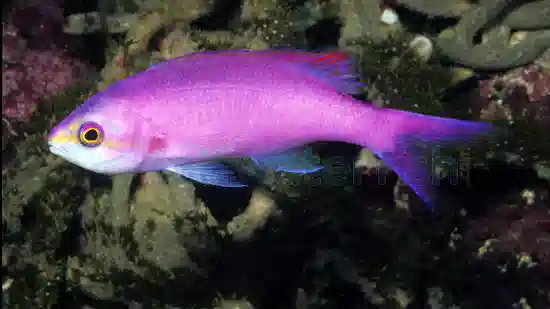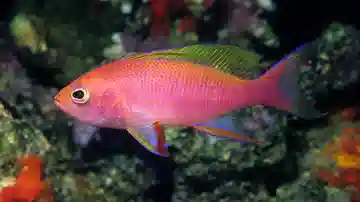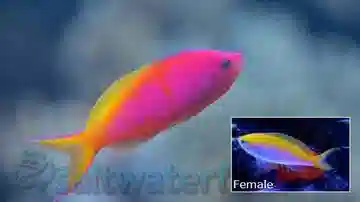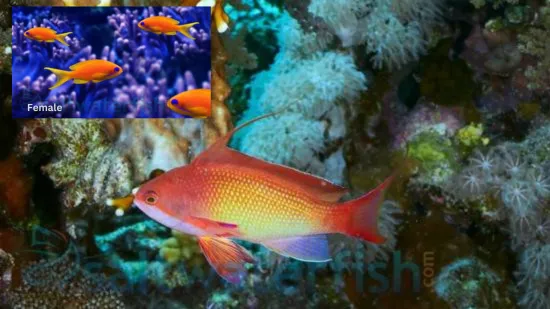Amethyst Anthias
Mirolabrichthys pascalus
(0 Reviews)

Amethyst Anthias
Mirolabrichthys pascalus
(0 Reviews)
{{ item.name }}
Size: {{ item.extra_field_3 }}
${{ getFormattedPrice(item.saleprice) }} ${{ getFormattedPrice(item.price) }}
To join the waiting list, click here
Free Shipping
With
$199.00
or more in Marine Life.
More details...
Amethyst Anthias Care Facts
| Care Level: | Moderate |
|---|---|
| Temperament: | Peaceful |
| Diet: | Carnivore |
| Origin: | Western Pacific Ocean |
| Acclimation Time: | 2+ hours |
| Reef Safe: | Yes |
| Minimum Tank Size: | 90 gallon |
| Max Size: | 8 inches |
Habitat of the Amethyst Anthias
The Amethyst Anthias is native to the Indo-Pacific region, including the Western Pacific Ocean and the Great Barrier Reef. It is typically found in shallow reef areas with plenty of hiding spots among corals and rocky crevices. In the wild, these fish form schools, adding to the beauty of their natural habitat.
Reef Compatibility of the Amethyst Anthias
The Amethyst Anthias is generally considered reef safe, making it a suitable choice for reef aquariums. These fish are unlikely to harm corals or invertebrates, making them a great addition to a thriving reef ecosystem.
Size and Lifespan of the Amethyst Anthias
Amethyst Anthias are medium-sized fish, with an average size of around 7-8 inches (20 cm) for adult specimens. They have a 3 to 5 years lifespan, although they can live longer in captivity with proper care.
Diet in Captivity of the Amethyst Anthias
In a saltwater aquarium, Amethyst Anthias should be provided with a varied diet to ensure their health and vibrant coloration. They are omnivorous, primarily feeding on zooplankton and small crustaceans in the wild. In captivity, you can feed them a diet consisting of high-quality marine pellets, frozen or live brine shrimp, mysis shrimp, and other small marine invertebrates.
Aquaculture Availability of the Amethyst Anthias
Amethyst Anthias were not commonly aquacultured, which means that most specimens available in the aquarium trade were collected from the wild. However, the availability of aquacultured specimens may have increased since then, so it's advisable to check with reputable suppliers for the latest information.
Compatibility with Other Fish and Invertebrates of the Amethyst Anthias
Amethyst Anthias are generally peaceful fish but can be territorial towards their own kind, especially in smaller tanks. Keeping them in small groups of one male and several females is recommended. They are also compatible with other reef-safe fish and invertebrates, making them suitable tankmates for a diverse community aquarium.
Sexual Dimorphism of the Amethyst Anthias
Amethyst Anthias exhibit sexual dimorphism, with males typically larger and displaying more vibrant coloration than females. The males have a deeper purple coloration, while the females are slightly smaller and more subdued.
Juvenile to Adult Coloration Changes of the Amethyst Anthias
Juvenile Amethyst Anthias are paler than adults. As they mature, their color deepens, and the characteristic amethyst-purple hue becomes more pronounced.
Temperament of the Amethyst Anthias
These fish are generally peaceful and make excellent additions to community saltwater aquariums. However, they can become territorial towards their kind if kept in close quarters with limited hiding spots. Providing ample hiding places and open swimming areas can help mitigate aggression.
Tank Requirements of the Amethyst Anthias
Minimum Aquarium Size: To provide a comfortable and stress-free environment for Amethyst Anthias, it is recommended to have an aquarium with a capacity of at least 90 gallons. Larger tanks are preferable, especially if you plan to keep a group of them.
Water Conditions of the Amethyst Anthias
- pH: Maintain a stable pH level between 8.1 and 8.4.
- Salinity: Keep the salinity level at 1.020 to 1.025.
- Water Temperature: The ideal temperature range for Amethyst Anthias is 75°F to 80°F (24°C to 27°C).
- Water Flow: These fish prefer moderate water flow, simulating their natural reef habitat. Provide gentle to moderate water movement in the aquarium.
Other Common Names of the Amethyst Anthias
Amethyst Anthias are known by various names in the aquarium trade, including Purple Queen Anthias and Plum Fairy Basslet.
Five Compatible Tank Mates (besides Yellow Tang) of the Amethyst Anthias
- Flame Angelfish (Centropyge loricula)
- Royal Gramma (Gramma loreto)
- Clownfish (Amphiprion spp.)
- Cleaner Wrasse (Labroides spp.)
- Firefish Goby (Nemateleotris spp.)
Why Choose Amethyst Anthias from Saltwaterfish.com
- Quality Assurance: Saltwaterfish.com is known for providing healthy and high-quality marine fish and corals. You can expect carefully selected and well-cared-for specimens when you purchase Amethyst Anthias from them.
- Expert Guidance: Saltwaterfish.com offers valuable information and guidance to help you successfully maintain and care for your Amethyst Anthias. Their team of experts can assist you in creating an optimal aquarium environment.
- Wide Selection: They may have a variety of fish and corals, allowing you to find compatible tank mates and build a diverse and visually stunning saltwater aquarium.
- Shipping Convenience: Saltwaterfish.com offers convenient shipping options, ensuring your new Amethyst Anthias arrive safely and in good health.
In conclusion, the Amethyst Anthias is a beautiful and reef-safe addition to a saltwater marine aquarium, with its striking coloration and peaceful temperament. When obtained from a reputable source like Saltwaterfish.com, you can enjoy the beauty and elegance of these fish in your home aquarium while contributing to the conservation of marine ecosystems.
Currently Amethyst Anthias does not have any reviews.












